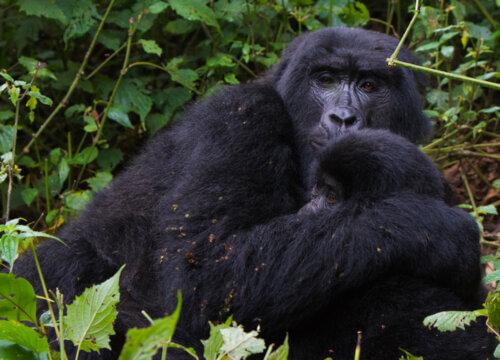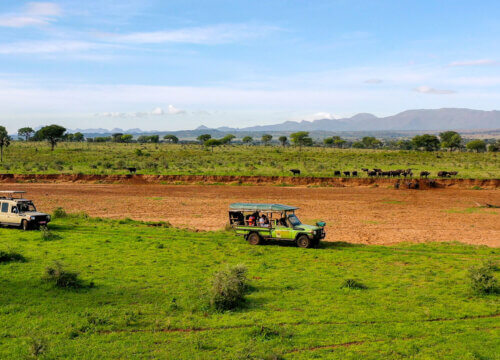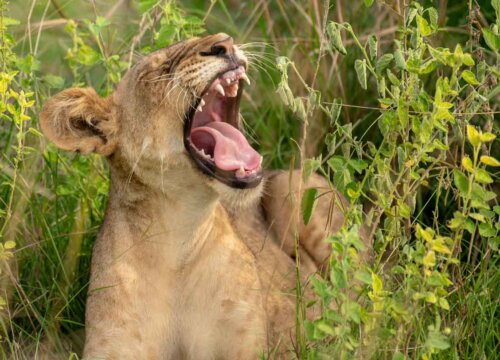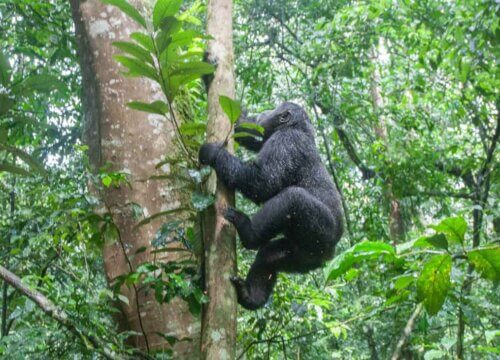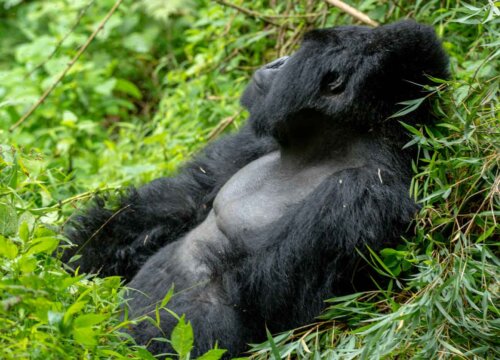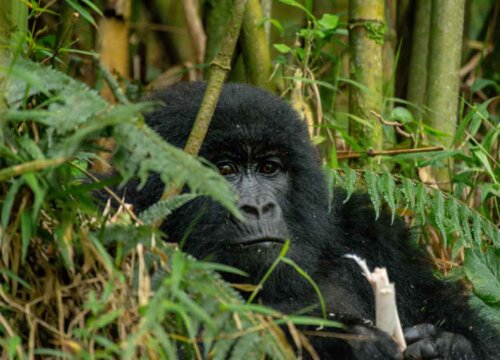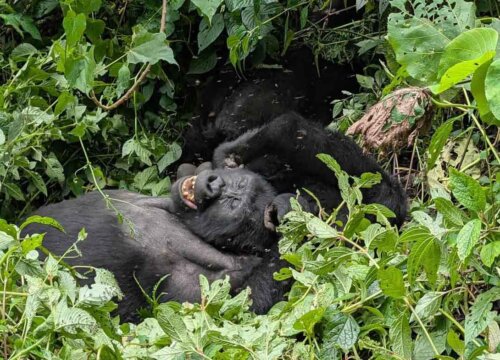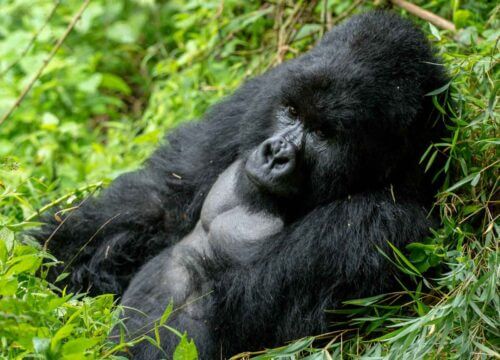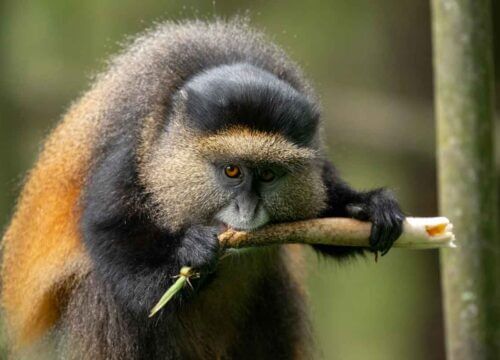Everything you need to know about mountain gorillas
Everything you need to know about mountain gorillas
Mountain gorillas are found in Uganda, Rwanda and DRC, are a subspecies of the Eastern gorilla known for their majestic appearance, gentle nature, and critically endangered status. They live in the high-altitude forests of central Africa where they face both natural and human made challenges. Their population is slowly recovering thanks to dedicated conservation efforts but they remain one of the world’s most endangered species.
What is the physical appearance of mountain gorillas?
Mountain gorillas are large powerful primates with thick black fur that helps them survive in cold mountain climates. Adult males known as silverbacks develop a distinct silver gray patch of fur on their backs giving them their name. They also have broad chests, muscular arms, and strong jaws, yet despite their imposing size they are gentle and peaceful by nature.
Where do mountain gorillas live?
Mountain gorillas are found in two main locations: the Virunga Mountains which stretch across Rwanda, Uganda, and the Democratic Republic of Congo (DRC) and Bwindi Impenetrable Forest in Uganda. These areas are characterized by dense forests, steep slopes and high altitudes perfect for mountain gorillas to thrive in relative isolation from human settlements.
What do mountain gorillas in Uganda & Rwanda feed on
Mountain gorillas are herbivores primarily feeding on a variety of plant material. Their diet consists of leaves, stems, fruit, bamboo, and occasionally tree bark. They can consume up to 40 kilograms (88 pounds) of food per day which helps maintain the delicate balance of the ecosystems they inhabit by controlling plant growth and dispersing seeds.
How do mountain gorillas live?
Mountain gorillas live in family groups led by a dominant male called a silverback. These groups consist of females, their offspring and sometimes subordinate males. The silverback plays a central role in protecting the group, leading them to food and defending against threats. Family bonds are strong and the group often stays together for years.
The Role of Silverbacks Mountain Gorillas in the Family
The silverback is the heart of a gorilla group. Not only is he the protector and decision maker, but he also nurtures the young. Silverbacks communicate with the group through body language, vocalizations and even chest beating, asserting their dominance and keeping the group cohesive and safe.
What is the reproduction and family life of Mountain Gorillas?
Female mountain gorillas give birth to a single infant after a gestation period of around 8.5 months. Babies are highly dependent on their mothers for the first few years of life, learning important survival skills including how to forage for food. Gorillas usually give birth every 3 to 4 years with infants spending around 4 years in infancy before maturing.
How do mountain Gorillas Communicate
Gorillas communicate through a variety of vocalizations including grunts, roars and growls. They also use facial expressions, body postures, and gestures to express emotions such as aggression, affection, or curiosity. For instance, a gorilla might beat its chest to show dominance or wave its hands to signal calm.
Are mountain gorillas considered highly intelligent creatures?
Mountain gorillas are highly intelligent and exhibit problem solving skills. They use tools to aid in their daily activities such as breaking open bamboo to eat. Gorillas also have complex social interactions and are known to form strong emotional bonds, not just with their immediate family but sometimes with other groups as well.
What are the treats faced by mountain gorillas
Mountain gorillas face several threats most notably habitat loss, poaching and disease. As human populations encroach on their habitat, gorillas are forced into smaller and more fragmented territories. Disease transmission from human’s especially respiratory illnesses also poses a serious risk to their health.
Habitat Destruction and Human Encroachment
As human populations grow in and around gorilla habitats, forest areas are cleared for agriculture, leading to habitat fragmentation. This limits gorillas’ access to food and increases human wildlife conflict. Conservationists work hard to balance human development and gorilla protection by promoting sustainable practices.
The Role of Eco-Tourism in Conservation
Eco-tourism specifically gorilla trekking has been vital in funding mountain gorilla conservation. By purchasing permits to track and observe gorillas, visitors contribute directly to the protection of these magnificent creatures. This also raises global awareness about the importance of conserving not only gorillas but also their ecosystems.
The Recovery of Mountain Gorilla Populations
Through intensive conservation efforts, the mountain gorilla population has slowly increased over the past few decades. From fewer than 250 individuals in the 1980s, the population has now surpassed 1,000. These efforts include habitat protection, anti-poaching patrols, and veterinary care, as well as community involvement.
Veterinary Care and Health Monitoring of mountain Gorillas in Uganda & Rwanda
Mountain gorillas are regularly monitored by wildlife veterinarians who track their health and intervene when necessary. The Gorilla Doctors team plays a crucial role in providing medical assistance to injured or sick gorillas. The health of the gorillas is critical for the overall success of conservation efforts.
Gorilla Trekking a Life Changing Experience in Uganda & Rwanda
Gorilla trekking is one of the most sought after wildlife experiences. Visitors trek through lush forests to find gorilla families, where they can observe these incredible creatures in their natural habitat. Trekking permits, which are limited, not only ensure responsible tourism but also provide significant financial support for conservation.
Best Places for Gorilla Trekking
The best places to trek mountain gorillas are Bwindi Impenetrable Forest and Mgahinga Gorilla National Park in Uganda, as well as Volcanoes National Park in Rwanda. These parks are home to habituated gorilla groups that are accustomed to human presence, making the trekking experience safe and rewarding.
Conservation Challenges Moving Forward
While mountain gorillas have made a remarkable recovery, they still face ongoing threats, including illegal poaching, disease, and habitat degradation. Future conservation efforts will need to address these challenges while ensuring the continued engagement of local communities in protecting gorillas and their environment.
What is the role of local communities in conservation?
Local communities play a key role in mountain gorilla conservation. Many communities around gorilla habitats benefit from eco-tourism and employment opportunities, such as guiding, hospitality, and park management. Community education and involvement in conservation programs ensure sustainable protection for both gorillas and their human neighbors.
What is the importance of Mountain Gorillas to Ecosystems
Mountain gorillas play an important ecological role by contributing to seed dispersal, maintaining plant diversity, and ensuring the health of the forests they inhabit. By protecting gorillas, we also safeguard the health of entire ecosystems that benefit countless other species.
Why Mountain Gorillas Matter Globally
Mountain gorillas are not just an African treasure, they are a global symbol of conservation success. Their survival offers hope that, with concerted effort and collaboration, even critically endangered species can recover. Protecting mountain gorillas helps preserve biodiversity and reminds us of the urgent need to protect our planet’s most vulnerable species.
Explorer More Safaris
- 14-Days Uganda Safari Gorilla Chimpanzees and Wildlife
- 12 Days Gorillas and Chimpanzees Wildlife Safari
- 10 days best of uganda primates & wildlife safari
- 6 Days Gorillas and Chimpanzee Trekking Safari
- 3 Day Bwindi Gorilla Trekking Safari
- 4 Day Uganda Gorilla Trekking and Wildlife Safari
- 4 Days Gorilla Trekking and Adventure Safari
- 5 Days Uganda Gorillas and Chimpanzee Tracking Safari
- 4-Day Rwanda Gorilla Trekking and Golden Monkey Tracking Safari
- 5 Day Gorilla Habituation and Chimp Trekking
- 4-Day Uganda & Rwanda Gorilla Trekking Tour
- 3 Days Bwindi Gorilla Trekking Ugnada from Rwanda
- 10 Days Uganda Primates and Game Safari

